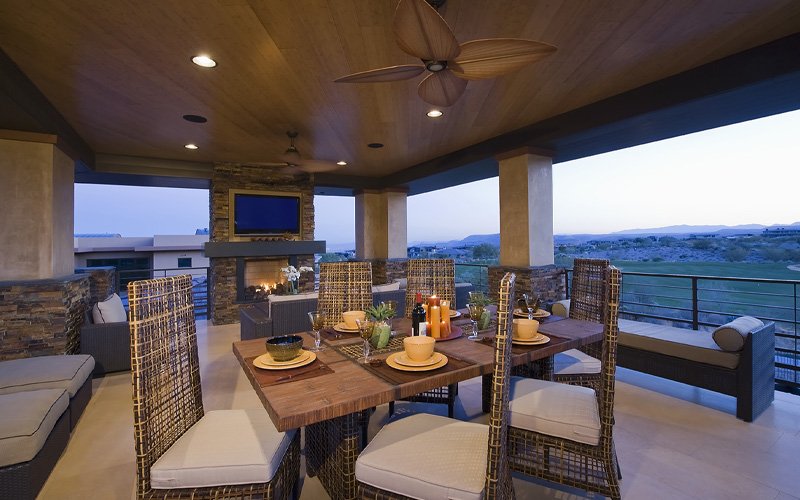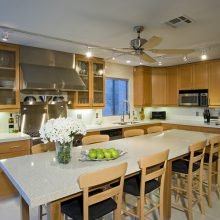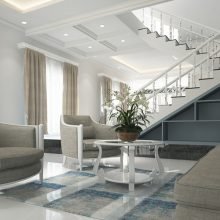Budget-Friendly Home Improvement Tips: Transform Your Space Without Breaking the Bank
Have you ever looked at a room in your house and felt that irresistible urge for change? Perhaps the walls seem lifeless, the furniture no longer matches, or you’re simply seeking a sense of renewal. The impulse to transform our spaces is natural—after all, our home is our sanctuary, and we want it to reflect our personality and provide comfort.
Budget-friendly home improvement tips are the perfect path for those who want to transform environments without compromising their finances. Many of us believe that significant renovations require enormous budgets, but the truth is that small strategic changes can have a surprising impact. With creativity, planning, and some intelligent techniques, you can breathe new life into your spaces while spending much less than you might imagine.
In this article, I’ll share proven methods for improving your home with limited resources, based on my experience helping hundreds of families transform their homes. You’ll discover how to evaluate your space, prioritize projects, save on materials, and apply techniques that make all the difference in the final result. The best part? These are solutions you can implement yourself, even without previous renovation experience.

Why Invest in Affordable Home Improvements?
Before diving into specific techniques, let’s understand why small improvements have so much value. When we transform our spaces, we’re not just changing the physical appearance—we’re creating environments that impact our daily well-being.
Studies show that our home environment directly affects our mood, productivity, and even sleep quality. A well-organized and aesthetically pleasing space reduces stress levels and increases feelings of control and comfort. This means that investing in your home, even with small changes, is also investing in your quality of life.
Additionally, well-planned improvements can increase your property’s value. Even modest renovations in key areas like kitchens and bathrooms frequently offer financial returns when it comes time to sell. And with the budget-friendly home improvement tips I’ll share, you’ll maximize this potential for appreciation without major expenditures.
Assessing Your Space: The First Step for Intelligent Transformations
Before picking up hammers and paint, take time to observe your space with critical eyes. This step is fundamental for directing your efforts and budget where they’ll make the most difference.
Start by walking through each room with a notepad. Observe:
- Which areas do you use most frequently?
- Where are the biggest functional problems (lack of space, poor lighting, disorganization)?
- Which visual elements are dated or don’t match your current style?
- Are there structural issues that need to be prioritized (leaks, electrical problems)?
Take photos of the environments from different angles. Sometimes, visualizing the space through images reveals aspects we overlook in day-to-day life. These photos will also serve as motivating “before” shots when you complete your projects.
Remember: not everything needs to be done at once. The art of budget-friendly home improvement tips lies in identifying what really matters and tackling projects gradually, as your budget allows.
Financial Planning: How to Define and Respect Your Budget
One of the biggest mistakes in home improvement projects is underestimating costs, leading to unexpected expenses and unfinished projects. Let’s avoid this trap with realistic financial planning.
Establishing Clear Priorities
Classify your projects into three categories:
- Urgent needs – Problems that affect safety, health, or basic functionality (like leaks or electrical issues)
- High-impact improvements – Changes that significantly transform the appearance or function of a space (like painting or organization)
- Future desires – Projects that would be nice but can wait
Focus first on categories 1 and 2, where your investment will have the greatest return in terms of well-being and functionality.
Calculating Real Costs
For each project on your priority list:
- Research the price of all necessary materials
- Add 15-20% for unforeseen expenses
- Consider tools you’ll need to buy or rent
- If hiring help, request at least three quotes
Use spreadsheets or budget apps to track all expenses. Several free tools are available and make this organization much easier.
Strategies to Save Money
- Buy materials gradually – Acquire non-perishable items (like tools or accessories) little by little, taking advantage of promotions
- Explore second-hand alternatives – Classified sites and construction material thrift stores offer options with up to 70% discount
- Negotiate discounts – Building supply stores frequently offer discounts for volume purchases or cash payments
Transforming Your Home on a Limited Budget: Techniques by Room
Now that you have a clear vision of your space and budget, let’s move to specific techniques for different areas of the house. These budget-friendly home improvement tips are tested and approved, combining low cost with high impact.
Living Room: The Social Heart of the Home
The living room is often the calling card of the home and, fortunately, small changes can transform it dramatically:
Strategic painting: An accent wall painted in a vibrant color costs little and completely changes the atmosphere. Choose a focal wall, such as the one that houses the TV or is behind the sofa. You’ll need just one gallon of paint for this project.
Furniture rearrangement: Sometimes, the problem isn’t the furniture itself, but its arrangement. Try different configurations that prioritize circulation and conversation. Draw a map of the room on graph paper and test layouts before moving heavy pieces.
New fabrics: Sofa covers, pillows, and new curtains are much cheaper than new furniture and instantly revitalize the environment. Look for durable, easy-to-clean fabrics for greater longevity of your investment.
Layered lighting: Replace single chandeliers with a layered lighting system (general light, task light, and ambient light). Affordable table lamps and floor lamps create cozy environments without major investments.
Kitchen: Transformations Without Demolition
The kitchen often seems to require expensive renovations, but there are accessible alternatives that make a huge difference:
Cabinet painting or refinishing: Instead of replacing cabinets, paint them with furniture-specific paint or apply adhesives that mimic wood or other materials. The cost is approximately 20% of the value of new cabinets.
Replacement of handles and knobs: This seemingly small detail has an impressive visual impact. Modern handles cost as little as $5 and bring instant personality to existing furniture.
Visible organization: Open shelving is trendy and saves money compared to closed cabinets. Install simple shelves to display beautiful dishes and ingredients in decorative jars.
New faucet: A modern faucet can cost between $20 and $60, but significantly updates the kitchen’s appearance and can improve functionality with features like adjustable spray or pull-down spout.
Bathroom: Luxury Without Major Works
Renovated bathrooms have excellent return on investment, and you can transform them with these affordable techniques:
Tile paint kit: There are specific products that allow you to paint old tiles without removing them. The result is surprisingly durable when properly applied and costs a fraction of a complete replacement.
Renewed grout: Deeply cleaning or replacing deteriorated grout between tiles makes the bathroom look new. Specific kits for this purpose cost about $10 and include everything you need.
Coordinated accessories: A matching set of towel bars, toilet paper holder, and soap dish creates a cohesive appearance for less than $30. Choose modern finishes like matte black or brushed gold.
Adequate lighting: Replace generic fixtures with bathroom-specific lighting, ideally neutral white, which favors activities like makeup application and shaving. LED strips around the mirror are a modern and accessible solution.
Bedrooms: Comfort Retreats
Our bedrooms should promote relaxation and well-being, and this doesn’t have to be expensive:
Quality bedding: Invest in a good set of sheets instead of structural renovations. 100% cotton fabrics with at least 200 thread count create a hotel-like sensory experience for a fraction of the cost of new furniture.
DIY headboard: Headboards give a sophisticated finish to the bedroom. Create yours with fabric stretched over an MDF board or using wall decals that simulate headboards. The average cost is $40, compared to $150 or more for a conventional headboard.
Visible organization: Invest in organizers for drawers and closets. The sense of order amplifies the tranquility of the environment without the need for new furniture or more space.
Plants: Species that purify the air like snake plants or peace lilies are affordable and bring life to the environment, in addition to helping with sleep quality.
DIY Solutions That Transform Any Environment
Some do-it-yourself techniques are versatile enough for application in various environments. These budget-friendly home improvement tips represent excellent cost-benefit:
Creative Painting Techniques
Painting goes far beyond simply covering a wall with uniform color:
Concrete effect: Mix gray paint with a little fine sand to create texture that resembles concrete, perfect for accent walls in industrial style.
Stencil: Reusable templates ($6-$20) allow you to create sophisticated patterns that look like expensive wallpaper.
Ombré: Gradually blend two colors to create an elegant gradient effect. Works especially well in home office walls or meditation areas.
Reuse and Upcycling
Transforming existing items not only saves money but also reduces waste:
Refreshed furniture: Second-hand solid wood furniture often has superior quality to new MDF pieces. Restore them with simple sanding and painting techniques.
Transformed pallets: Discarded pallets can become functional furniture such as porch sofas, coffee tables, or bed frames, costing only the value of screws and finishing.
Reinvented crates: Wooden crates from farmer’s markets, when sanded and painted, become modular shelves, side tables, or versatile organizers.
Lighting Solutions
Proper lighting instantly transforms any environment:
Indirect lights: LED strips behind furniture or under cabinets create a sophisticated atmosphere for minimal cost (starting at $10 for five meters).
DIY pendants: Create exclusive pendant lights using unusual materials such as metal colanders, artisanal baskets, or even large glass jars.
Dimmers: Intensity controllers cost approximately $10 and allow you to adjust the lighting according to the occasion, maximizing the potential of the lights you already have.
Low-Cost, High-Impact External Improvements
The facade and external areas are often neglected in economic projects, but they can completely transform the impression your house makes:
Strategic Gardening
Well-positioned plants immediately beautify any property:
Defined flower beds: Use border stones to create well-defined beds. The organized visual elevates the appeal even with simple and accessible plants.
Perennial plants: Invest in species that return year after year without replanting, such as lavender, rosemary, and hydrangeas, saving in the long run.
Ground cover: Materials such as pine bark or pebbles are relatively inexpensive and keep beds looking well-maintained even with little maintenance.
Renewed Entrance
The entrance defines the first impression of visitors:
Colorful door: An entry door in a vibrant color draws positive attention and requires only a quart of special exterior paint (approximately $15).
Modern numbers: Contemporary style house numbers cost between $10 and $30 and instantly update the facade.
Path lighting: Solar lights for pathways cost from $3 each and require no electrical installation, offering security and style.
External Living Spaces
Creating areas to enjoy the outdoors expands the sense of space in the house:
Modular deck: Using pre-fabricated modular decking costs approximately half the value of a deck built from scratch and can be installed by anyone.
Fire pit: A simple fire pit made with heat-resistant stones or a pre-fabricated model starting at $40 instantly creates an outdoor gathering point.
Simple pergola: Basic pergola structures for climbing plants cost about $100 in materials and create an inviting shaded area at a cost far below a traditional covered porch.
Techniques to Maximize Small Spaces
Often, the challenge is not just the budget, but limited space. These budget-friendly home improvement tips help optimize every inch:
Vertical Solutions
Take advantage of walls to free up floor space:
Floating shelves: Sturdy models cost from $6 and can replace dressers and side tables in tight spaces.
Wall organizers: Modular systems for kitchen or home office keep utensils and materials accessible without occupying work surfaces.
Vertical garden: Structures for vertical plants maximize greenery in small balconies and even on internal walls with good lighting.
Multifunctional Furniture
Each item should fulfill multiple purposes:
Storage ottomans: Serve as extra seating, footrest, and storage space starting at $30.
Extendable tables: Models that expand only when necessary allow you to accommodate visitors without sacrificing space daily.
Sofa beds: Modern versions are much more comfortable than old models and transform an office into a guest room when needed.
Visual Illusions
Techniques that make environments appear larger:
Strategic mirrors: Positioned to reflect windows or focal points, mirrors visibly amplify space. Simple models cost from $20.
High curtains: Install rods close to the ceiling instead of just above the window to create the illusion of higher ceilings.
Monochromatic palette: Using various shades of the same color creates depth without breaking visual continuity, making environments appear larger.
Preventive Maintenance: Save by Avoiding Problems
An essential part of budget-friendly home improvement tips is avoiding unnecessary repair expenses:
Regular Inspections
Establish a routine to check problem areas before they become expensive:
Roof and gutters: Inspect twice a year, especially before the rainy season. Cleaning gutters costs practically nothing beyond your time but prevents infiltrations that can cost thousands.
Seals: Check grout, silicone, and seals around windows annually. Preventive repairs cost cents per linear foot, while moisture damage can be extremely expensive.
Plumbing installations: Regularly check under sinks and around toilets for signs of leaks. Kits for simple repairs cost between $6 and $10.
Preventive Products and Techniques
Small investments in prevention bring big savings:
Waterproofing: Applied to exterior wood and concrete areas significantly increases their lifespan. A gallon costs approximately $30 and protects considerable areas.
Clean air conditioner filters: Regularly replacing or cleaning saves up to 15% on energy bills and prevents expensive equipment maintenance.
Thermal insulation: Weather stripping for doors and windows costs approximately $4 per door and significantly reduces climate control expenses.
Basic Maintenance Skills
Learning simple techniques eliminates calls to professionals for minor repairs:
Replacing faucets and showerheads: Complete kits include detailed instructions, and replacement takes less than an hour for beginners.
Repairing small holes in walls: Specific compounds for this purpose cost about $3 and allow you to repair damage such as nail holes without calling professionals.
Unclogging drains: Preventive enzymatic products cost approximately $6 and prevent clogs that might require expensive specialized services.
Planning the Next Level: How to Prepare for Larger Projects
Eventually, you may want to advance to more significant improvements. Prepare properly:
Learning New Skills
Invest in knowledge before materials:
Free online courses: Platforms like YouTube and specialized websites offer detailed tutorials for almost any residential project.
Workshops at hardware stores: Many home center chains offer free demonstrations of techniques such as floor installation or basic electrical work.
Community groups: Join local DIY groups to exchange knowledge and even tools, reducing costs.
Building a Basic Tool Kit
Invest gradually in essential tools:
First acquisitions: Start with a hammer, set of screwdrivers, pliers, measuring tape, and bubble level. This basic kit allows for a surprising variety of projects.
Second phase: As your confidence grows, add a drill, circular saw, and sander to expand your possibilities.
Strategic rental: For very specific use tools, such as plunge saws or floor sanders, renting is more economical than buying.
Recording Completed Projects
Document your achievements:
Visual portfolio: Keep before/after photos of each project to track your progress and motivate yourself for new challenges.
Learning journal: Note difficulties encountered and solutions applied in each project for future reference.
Savings calculation: Record how much it would cost to hire professionals versus your investment in tools and materials to visualize the accumulated savings.
Conclusion: Your Home, Your Evolving Masterpiece
Implementing budget-friendly home improvement tips isn’t just about saving money—it’s about creating a deeper connection with your space and developing skills that last a lifetime. Each project you complete adds not only value to your property but also confidence in your ability to transform environments.
Remember that the best renovations respect both your budget and your individuality. In a world of standardized designs, your home can and should reflect your unique story, personal preferences, and aesthetic vision.
Start small, celebrate each achievement, and allow yourself to learn from any mistakes. Over time, you’ll develop a trained eye to identify improvement opportunities and the confidence to implement them with creativity and efficiency.
Most importantly: have fun in the process. Transforming a space with your own hands brings incomparable satisfaction, especially when you achieve professional results with minimal investment. Your home is a project in constant evolution—just like you.
Key Points About Budget-Friendly Home Improvements
- Effective transformation begins with careful observation and strategic planning
- Prioritize projects by necessity, visual impact, and available budget
- Small changes such as painting, organization, and hardware updates have an impact disproportionate to their cost
- Accessible DIY techniques allow professional results without specialized knowledge
- Preventive maintenance is as important as visible improvements
- Documenting projects increases motivation and allows you to evaluate progress over time
- Each skill developed facilitates more ambitious future projects
Meta description: Discover budget-friendly home improvement tips that transform environments without compromising your finances. In this complete guide, we present simple techniques to renovate every space, from the living room to external areas, focusing on practical and accessible solutions for beginners.








